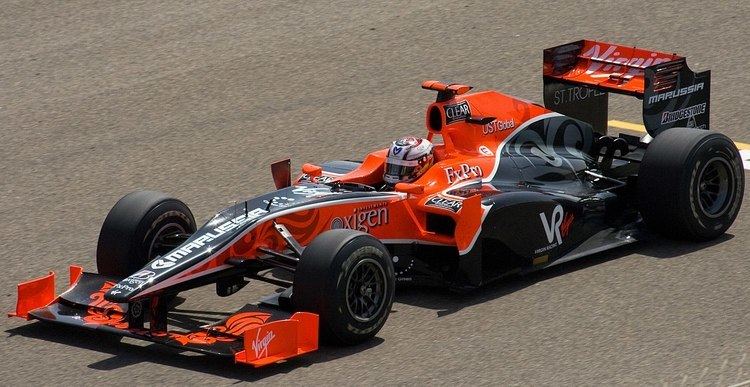 | ||
Suspension (front) carbon-fibre wishbones with titanium flexure joints, aluminium alloy uprights, Penske dampers | ||
The Virgin VR-01 was a Formula One motor racing car designed by Nick Wirth for Virgin Racing in the 2010 season. It was driven by former Toyota driver Timo Glock and Brazilian ex-GP2 driver Lucas di Grassi. The car was the first Formula One racing car designed entirely with computational fluid dynamics. The car was due to be launched online through the official team website on 3 February 2010, but technical issues prevented the live internet broadcast from taking place.
Contents
Development
It had been reported by Auto, Motor und Sport that the VR-01's fuel tank was too small for the car to finish a race, and that the team applied to the Fédération Internationale de l'Automobile (FIA) in order to obtain permission to modify the chassis to accommodate a larger tank. The revised chassis, with a longer underbody, engine cover and other bodywork changes, was expected to be introduced at the Spanish Grand Prix. This was later clarified to mean that the car would struggle to complete races with a heavy rate of fuel consumption.
Racing history
The car passed its mandatory FIA crash tests, and completed its first track run at Silverstone on February 4 in the hands of Glock. It tested with other teams for the first time at the group test at Jerez from February 10 to 13. On the first day, Glock completed five laps of the track during wet weather conditions. On the second day, he completed eleven laps before the car's front wing failed; the team had to abandon the day's running due to a shortage of spare parts. Virgin modified the front wing mounting of the VR-01 ahead of the third day's running in Jerez, where di Grassi ran the Virgin for the first time. The following test was plagued by weather conditions and the car suffered a hydraulic problem on the first test day and Glock only managed 10 laps. On the next day Glock notched up 72 laps for the car and had no mechanical problems, however the weather was still wet. Di Grassi took over for the remaining two days of the test. Technical director Wirth said that the hydraulic problem was solved and the car has not had any big glitches. The problem recurred, however, at the final pre-season testing session held at Catalunya, costing the team further track time and necessitating a further redesign of the relevant components ahead of the Bahrain Grand Prix.
Glock was the fastest driver of the new teams in qualifying for the Bahrain Grand Prix, but both he and Di Grassi retired from the race with further hydraulics problems. Di Grassi managed to finish in Malaysia, ending the race in fourteenth position ahead of rivals Lotus Racing and Hispania Racing, albeit on fuel conservation mode.
Complete Formula One results
(key) (results in bold indicate pole position; results in italics indicate fastest lap)
† Driver failed to finish, but was classified as they had completed >90% of the race distance.
